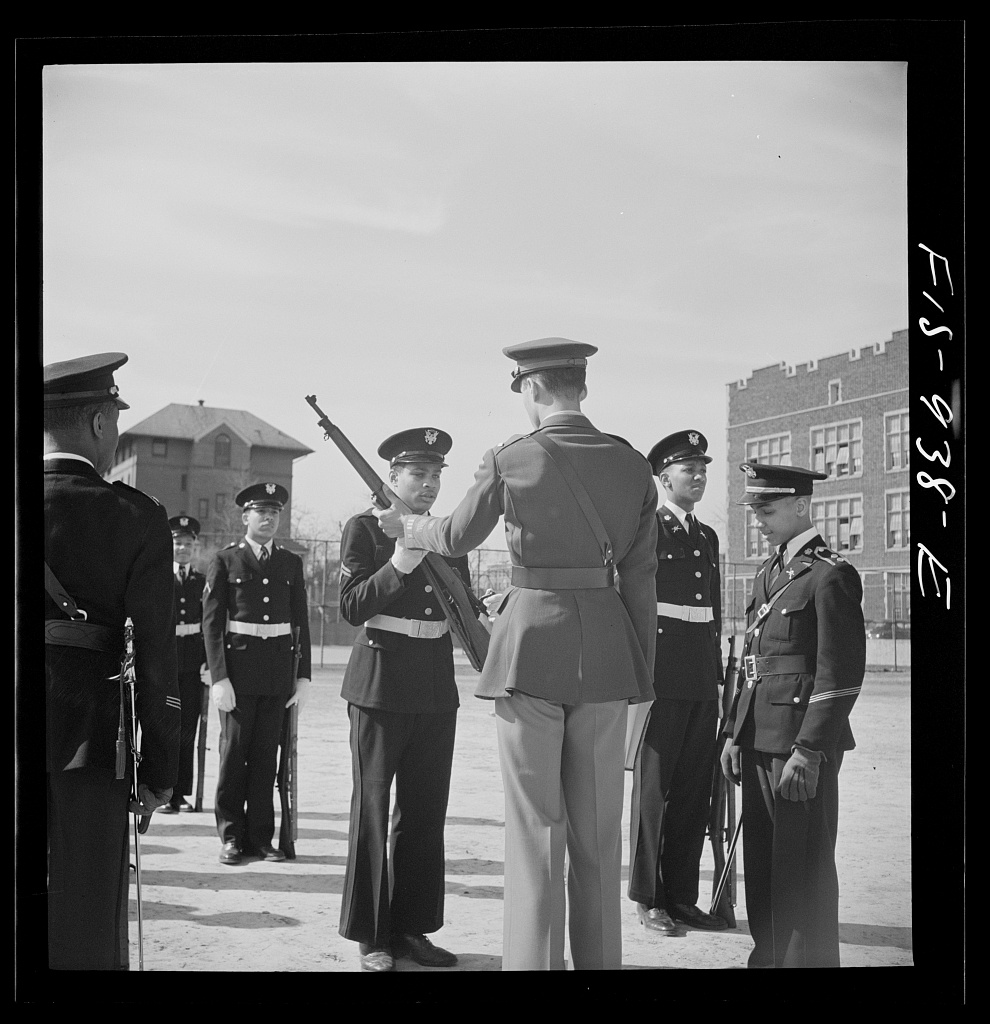
Happy Memorial Day to all who have served. Be ye ROTC, whatever this was, or any of the branches of our military. Thank you for your service.
Let’s take a break from the Washington Sanitary Improvement Company houses and look at some old photos of Truxton Circle schools.
Below is Armstrong Technical High School in March 1942.
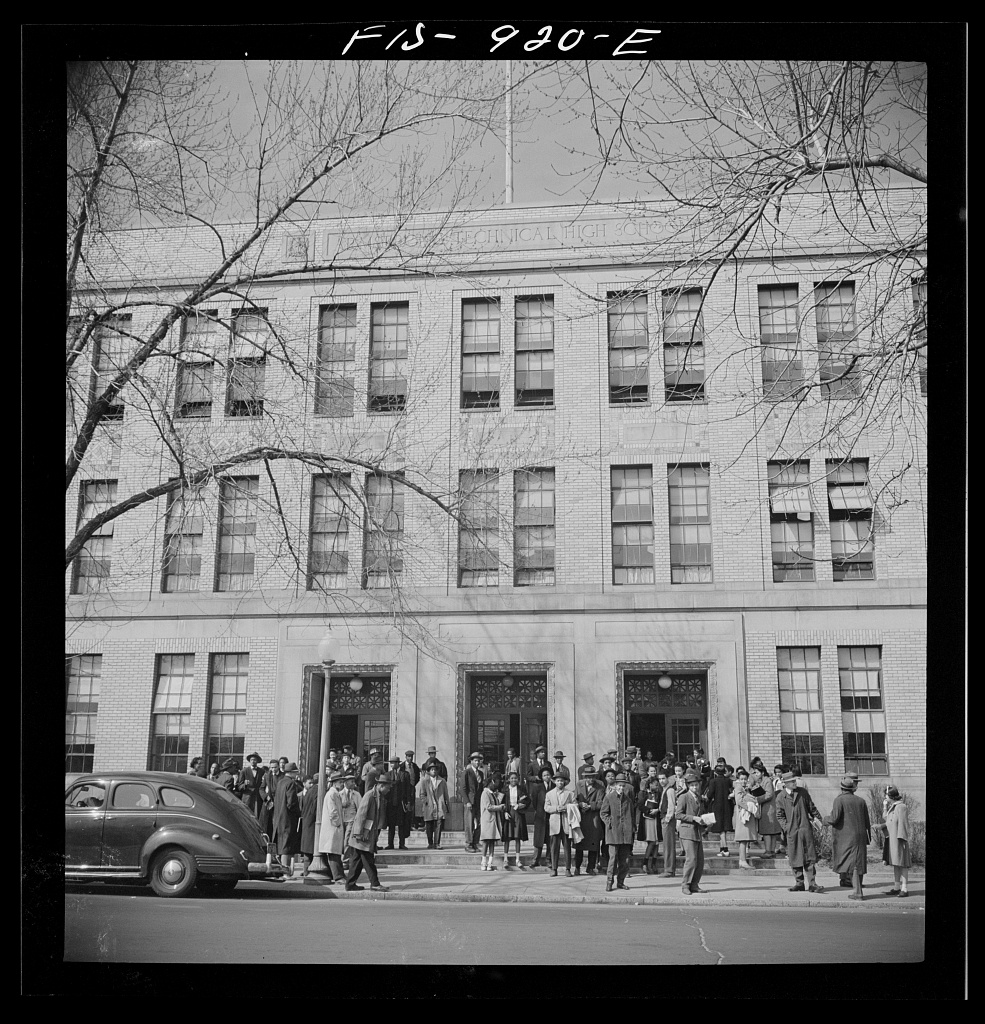
If I were to guess this is probably the P Street side of the school. Free free to argue with me in the comments.
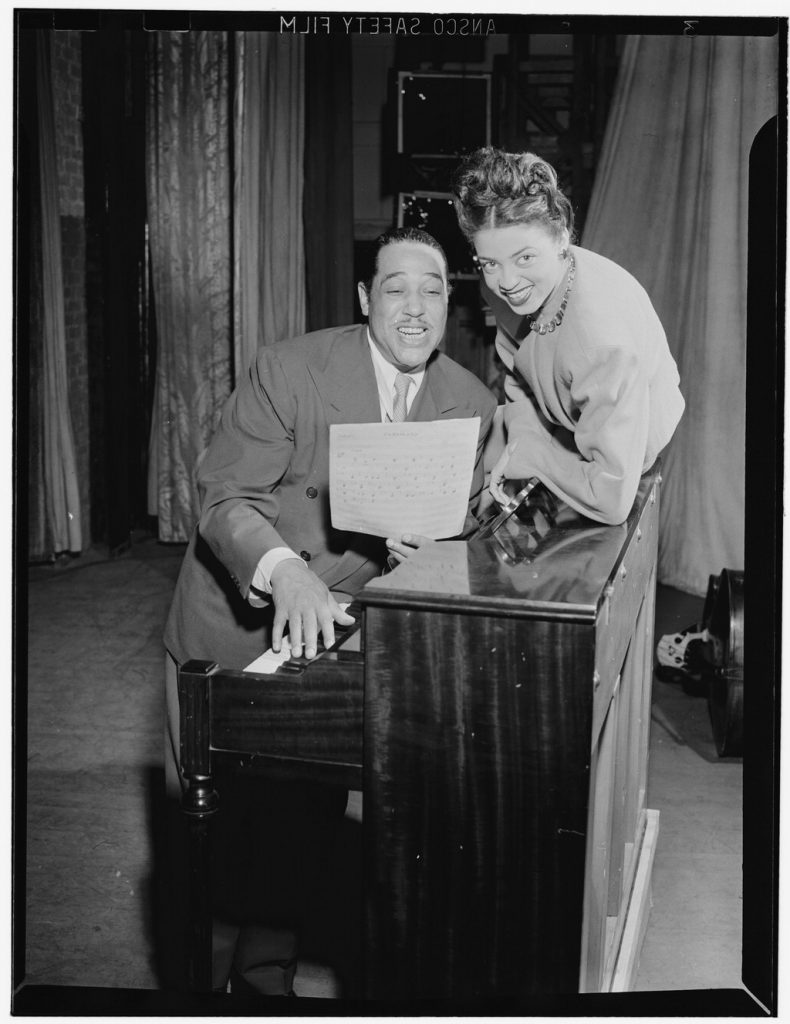
Duke Ellington, for whom a bunch of buildings around DC are named, attended Armstrong to study art and design.
Currently, Armstrong is the location of one of the Friendship Charter Schools for Pre-K and elementary aged children.
The Washington Sanitary Improvement Company (WSIC) was a late 19th century charitable capitalism experiment that ended in the 1950s. This blog started looking at the homes that were supposed to be sold to African American home buyers, after decades of mainly renting to white tenants.

Looking at WSIC properties they tend to have a pattern where the properties were sold to a three business partners, Nathaniel J. Taube, Nathan Levin and James B. Evans as the Colonial Investment Co. for $3 million dollars. Those partners sold to African American buyers. There was usually a foreclosure. Then the property wound up in the hands of George Basiliko and or the DC Redevelopment Land Agency (RLA). Then there was the odd lucky ones who managed to avoid that fate.
Let’s see what happens with 201 P St NW:
This transaction went as well as it could. No foreclosures. For some reason there was a Basiliko document but I could not link a deed to him for this property. So I ignored it. And if no Basiliko, there is no DC RLA or any other DC government scheme to rehabilitate the property.
In 2012, the property was united under one owner. According to that document the Wrights and Ms. Ferguson were all dead and their estates sold their halves. Paul Wright died 1952. Johnnie Mae Wright died in March 2005, Herbert Champion and Dorothy Simpson Dickerson represented her estate. Catherine Estep Ferguson, later Catherine Olivia Milner died January 26, 2005. Her estate was represented by son Michael James Milner and companion, Paul Woods.
Sometimes due to a bad read by the OCR or fat fingers the wrong document shows up out of no where. There was a 1953 document I ignored because neither party was on the deed. The borrowers borrowed 804.86 for work done by the Consolidated Engr. & Distr. Co, Inc. at 201A P Street NW. So this and the Basiliko document are the two that made no sense in the history of this house.
The Washington Sanitary Improvement Company (WSIC) was a late 19th century charitable capitalism experiment that ended in the 1950s. This blog started looking at the homes that were supposed to be sold to African American home buyers, after decades of mainly renting to white tenants.
Currently, 18 O Street NW has been divided into condos and there isn’t a convenient DCRA photo from 2004 to look at. But thankfully the lot next door, currently lot 237, for 16 O St NW. From the 1909 map it appears 18 O Street NW is on lot 181. I am guessing 18 O may have also been lot 236.
Looking at WSIC properties they tend to have a pattern where the properties were sold to a three business partners, Nathaniel J. Taube, Nathan Levin and James B. Evans as the Colonial Investment Co. for $3 million dollars. Those partners sold to African American buyers. There was usually a foreclosure. Then the property wound up in the hands of George Basiliko and or the DC Redevelopment Land Agency (RLA). Then there was the odd lucky ones who managed to avoid that fate.
 Let’s see what happens with 18 O St NW:
Let’s see what happens with 18 O St NW:
I don’t know what connection, if any the Housing System Dev. and Construction Corp had to DC’s RLA. What I can see in the record is that the property somehow still required Basiliko’s involvement and they were condemned at a point. So whatever supposed construction that was supposed to take place, probably didn’t.
Okay let’s get out the bingo card. Halves of one property sold to two separate households, check. The sole lenders were Abraham H. Levin and Robert G. Weightman, check. Foreclosure, check. Sold to George Basiliko, check. Sold to DC RLA? Nope.
The Washington Sanitary Improvement Company (WSIC) was a late 19th century charitable capitalism experiment that ended in the 1950s. This blog started looking at the homes that were supposed to be sold to African American home buyers, after decades of mainly renting to white tenants.

Looking at WSIC properties they tend to have a pattern where the properties were sold to a three business partners, Nathaniel J. Taube, Nathan Levin and James B. Evans as the Colonial Investment Co. for $3 million dollars. Those partners sold to African American buyers. There was usually a foreclosure. Then the property wound up in the hands of George Basiliko and or the DC Redevelopment Land Agency (RLA). Then there was the odd lucky ones who managed to avoid that fate.
Let’s see what happens with 60 Bates St NW:
It appears that between 1972-1980 the DC Redevelopment Land Agency gains control of 60 Bates Street. The document showing the transfer from Basiliko to DC RLA is somewhere but does not appear for this property.
So lets check our WSIC sell off bingo card. Half of the property sold to two different households, check. Same lender for all borrowers, check. Foreclosure, check. Sold to Basiliko, check. Sold to DC RLA, I can’t find the paperwork, but check.
People in academia tend to like to tell research adventure stories. The problem with archives and libraries and other places digitizing everything is taking the romance out of these tales. No need to get a grant, rent a crappy motel room during the middle of summer, nah. Tippy-tip tap, an email here, a subscription to a certain website and there’s your document. Of course, not everything has been digitized. And because of that, a person could still have a research adventure.
My research adventure takes place at the National Archives in College Park, MD. Those who know me are probably rolling their eyes, but bear with me. So my goal was to find the lost redlining map of Washington DC. I can call it lost, ’cause it was a b!tch to find. For one, the Mapping Inequality site showing off redlining maps doesn’t have Washington, DC. The DC Policy Center and Mapping Segregation had a map on their sites that approximated or was very similar to a DC version of the redlining map.
The DC Policy Center just said it came from the National Archives. Ok. NARA has a bunch of stuff and it’s catalog can be a PITA when you’re trying to actually find something. Clicking source just brought a person to the Mapping Segregation site. Digging into the resources there would send you back to the DC Policy Center and round and round I went. I eventually found the citation at the end of http://mappingsegregationdc.org/assets/residential-sub-areas-for-website-rev.pdf. It narrowed it down to the record group (RG) and the box, but not the entry. More poking around and it was entry A1-6.
I got the box. I was in the research room scanning area. I was at a desk next to a dear friend who is a professional researcher showing me the ropes and I managed to scrounge up an SD card for the camera. But the monitor was acting funny. And the SD card was ‘corrupt’. I managed to fit just 2 images on the card before giving up. And below was what I was able to capture.
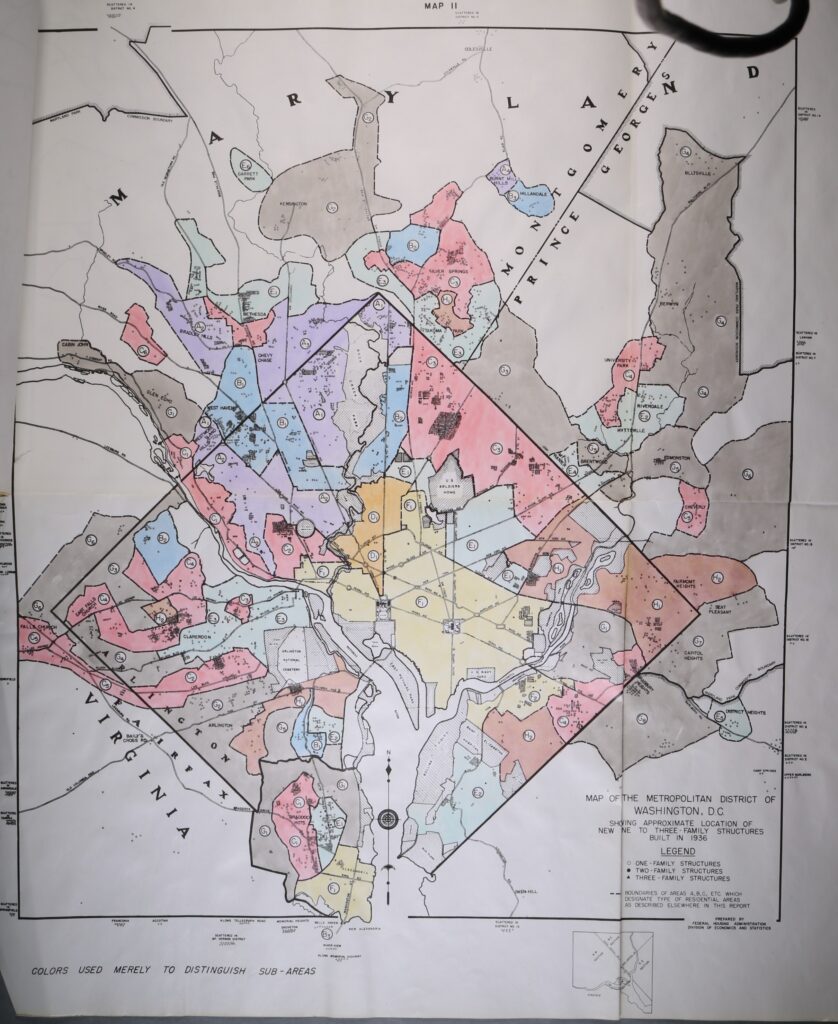 Source: Map 11. Housing Market Analysis Washington DC. Records Relating to Housing Market Analyses, 1940–1942. National Archives, College Park, MD RG 31, entry A1 6, (NAID 122213881)
Source: Map 11. Housing Market Analysis Washington DC. Records Relating to Housing Market Analyses, 1940–1942. National Archives, College Park, MD RG 31, entry A1 6, (NAID 122213881)
A description of the letter based residential sub-areas.
The Washington Sanitary Improvement Company (WSIC) was a late 19th century charitable capitalism experiment that ended in the 1950s. This blog started looking at the homes that were supposed to be sold to African American home buyers, after decades of mainly renting to white tenants.
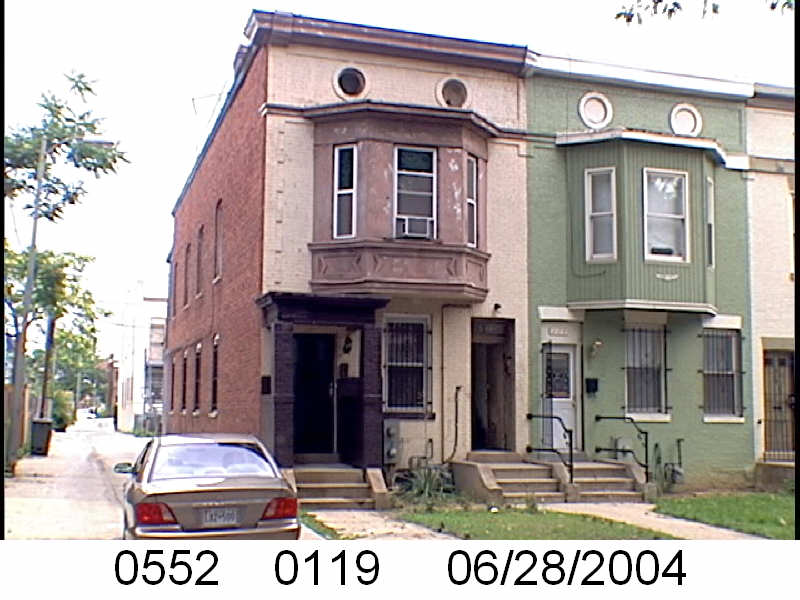
Looking at WSIC properties they tend to have a pattern where the properties were sold to a three business partners, Nathaniel J. Taube, Nathan Levin and James B. Evans as the Colonial Investment Co. for $3 million dollars. Those partners sold to African American buyers. There was usually a foreclosure. Then the property wound up in the hands of George Basiliko and or the DC Redevelopment Land Agency (RLA). Then there was the odd lucky ones who managed to avoid that fate.
Let’s see what happens with 231 P St NW:
After that things get messy. I don’t like to look at these records past the 1980s and 1990s because that brings me ever closer to bumping into people I might have known. And it is just weird.
Basiliko, in the form of George Basiliko with wife Sophia, and George Basiliko Inc., had a couple of real estate documents between 1962 and 1978. December 1978 George Basiliko Inc sold his half of 231 P St NW to Lewis L. Washington.
June 1980 Norris added Patricia Butler to the deed. Propertyquest has Patricia Butler is the current owner….. Okay. I didn’t see when/how it came under one owner.
So let’s check our WSIC bingo card. Sale of half of the property, eventually, check. Foreclosure, check. Sale to Basiliko, check. Sale to DC Redevelopment Land Agency, nope.
I haven’t done this in a while.
So just to get an idea to see if what I am seeing with the Black Homeowners of Truxton Circle is normal, or not, I am comparing them with white home owners. I am looking at blocks that were over 90% white in 1950 but also in the same “red lined” zone, which was F1.
The story starts in 1924 when John and his wife Mae Fitzpatrick purchased 501 3rd St SE from John J. and May Shaughnessy. As part of the purchased the Fitzpatricks borrowed the equivalent of $5000 from the American Building Association. They also borrowed $2,000 from trustees Charles H. Kindle and Guy M. Neely at 6% interest. The $2,000 loan was paid off in 1927. In 1931 the Fitzpatricks borrowed a small amount of money ($184.00) and paid it off in 1933. The Fitzpatricks were free and clear of their 1924 American Building Assoc. loan in 1946. They sold their home in 1952.
So who was John Fitzpatrick? He was at the same address for the 1930-1950 censuses, so I can find the right John Fitzpatrick out of all the other John Fitzpatricks. Let’s start in 1922 when John Fitzpatrick married Irish born Mae/May Quade/Quaid at St. Peter’s Church. Two years later the newlyweds purchased 501 3rd St SE.
On the 1930 census New York born Irish-American John was a 48 year old US government auditor. He lived with his wife Mae, and their children John, Helen and William. The next census, 1940, John (58 y.o) was a government “general clerk” and Mae was Mary. The last census, 1950, two of the, then adult, children lived with John and Mary, John D. and William L. John Daniel Fitzpatrick married a Ms. Evelyn Elaine White in April of 1951. They moved out and went to live at 2115 Suitland Terrace SE.
Because John Fitzpatrick is such a common name, my research ends here.
Comparing the white Fitzpatricks with the Black Truxton Circle home owners, only one TC person also had an American Building loan. William Bowman of 20A N St NW refinanced with the American Building Association.
The Washington Sanitary Improvement Company (WSIC) was a late 19th century charitable capitalism experiment that ended in the 1950s. This blog started looking at the homes that were supposed to be sold to African American home buyers, after decades of mainly renting to white tenants.
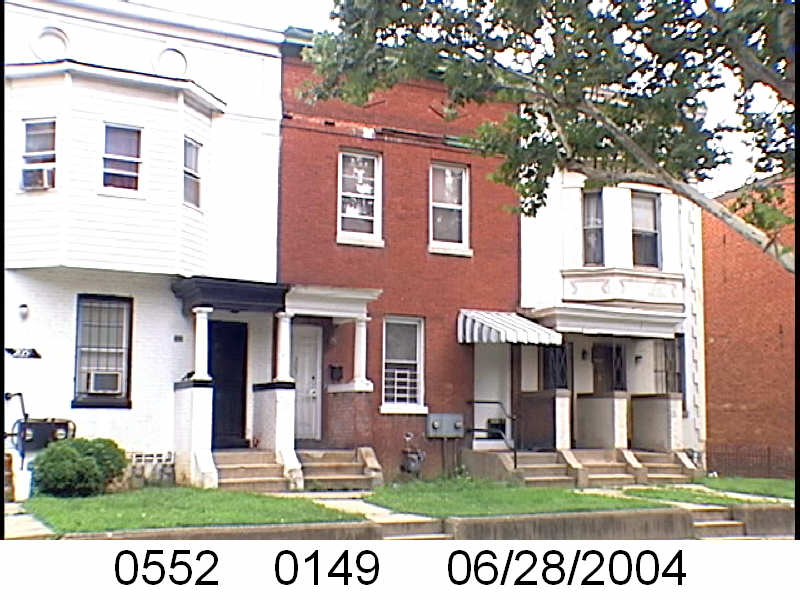
Looking at WSIC properties they tend to have a pattern where the properties were sold to a three business partners, Nathaniel J. Taube, Nathan Levin and James B. Evans as the Colonial Investment Co. for $3 million dollars. Those partners sold to African American buyers. There was usually a foreclosure. Then the property wound up in the hands of George Basiliko and or the DC Redevelopment Land Agency (RLA). Then there was the odd lucky ones who managed to avoid that fate.
Let’s see what happens with 203 P St NW:
I will leave it in the 1970s. Let’s check our WSIC checklist. Half of the building sold to two separate households, check. Foreclosure, check. Half or all of the property sold to George Basiliko, check. Sold to DC RLA or any associated private partners, nope.
The Washington Sanitary Improvement Company (WSIC) was a late 19th century charitable capitalism experiment that ended in the 1950s. This blog started looking at the homes that were supposed to be sold to African American home buyers, after decades of mainly renting to white tenants.
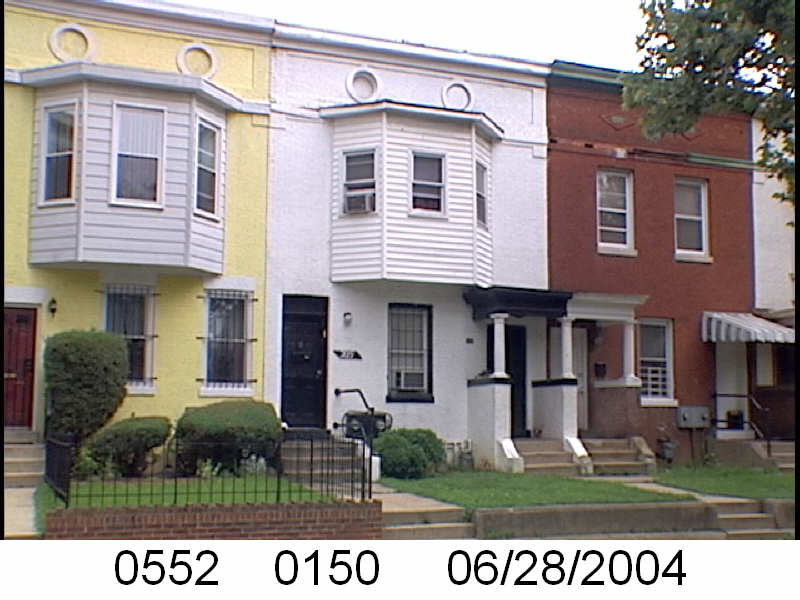
Looking at WSIC properties they tend to have a pattern where the properties were sold to a three business partners, Nathaniel J. Taube, Nathan Levin and James B. Evans as the Colonial Investment Co. for $3 million dollars. Those partners sold to African American buyers. There was usually a foreclosure. Then the property wound up in the hands of George Basiliko and or the DC Redevelopment Land Agency (RLA). Then there was the odd lucky ones who managed to avoid that fate.
Let’s see what happens with 205 P St NW:
I have no idea what was going on in the 1980s. On the surface it looks like George Basiliko sold/transferred the property to different people who then got foreclosed upon and he wound up getting the property back. Idk. I’m not looking all that closely. By the time the property came under one owner I gather the chance to dump it on DC RLA for a pretty penny passed. Checking our WSIC bingo card we have selling two halves, check. A foreclosure, check. Selling to George Basiliko, check. But no sale to DC RLA or any of its associated private partners.